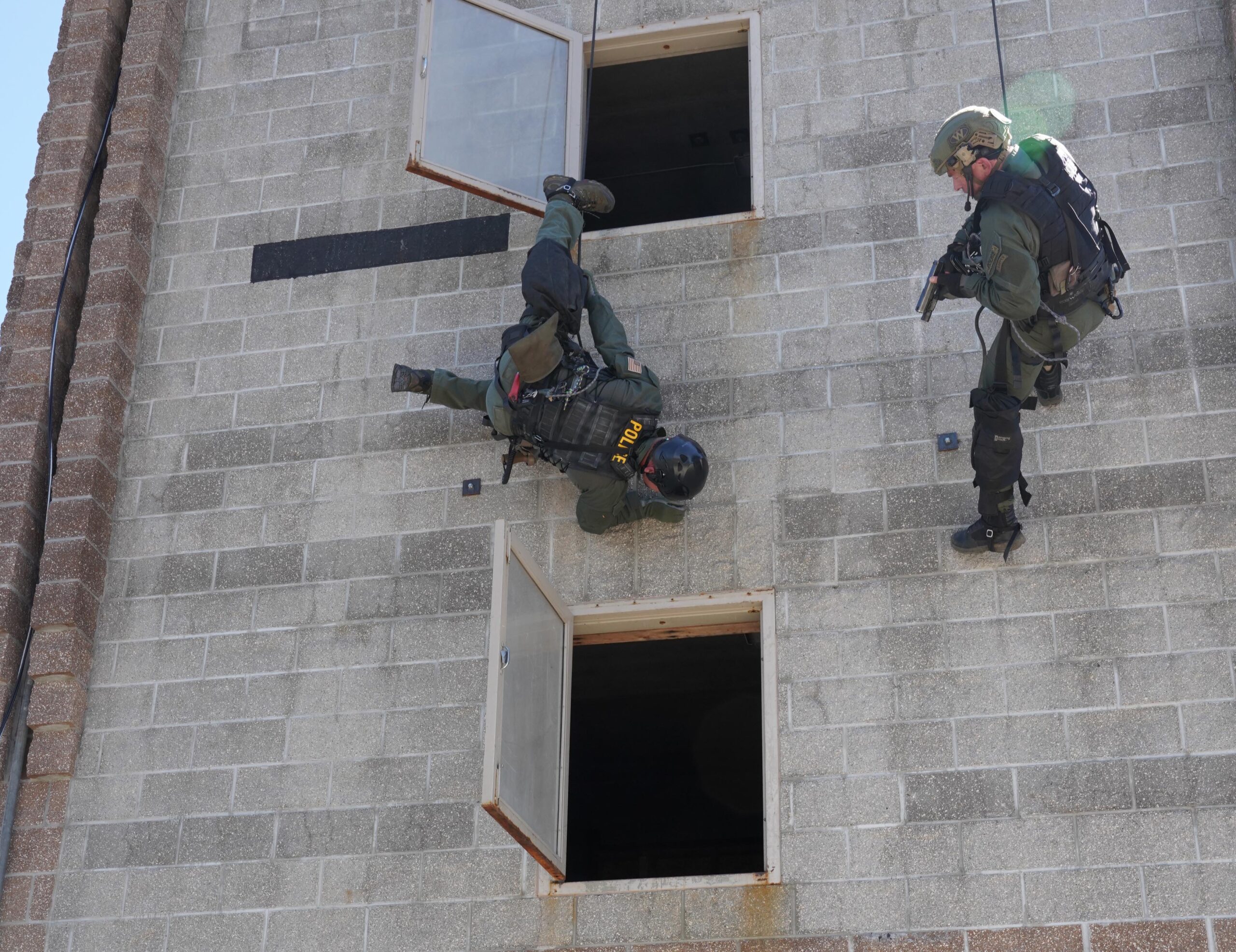
Tactical Rope Operations Course L1/L2 2021-05-10
Location: Redmond, Oregon (Vertically Speaking Tactical training center)
The Tactical Rope Operations Course (TROC) is a 45 hour course designed to give law enforcement officers an alternative safe solution to many situations, and develop true vertical mobility in a tactical situation, that is, an incident that involves a human antagonist, armed or unarmed. Course will be held at the Vertically Speaking training center located in Redmond Oregon. Components of the class will also occur at the Bend Fire Department training tower and at COSSA (firing range).
Target Audience: Special Operations police and military units tasked with direct action operations to access areas by a vertical medium (urban or wilderness) to effect an arrest, conduct hostage rescue, remove vertical protesters, intervene with suicide jumpers, rescue / transport downed operators, set up over watches or containment, board vessels, or infiltrate criminal facilities.
Pre-requisites: There is no specific course pre-requisite, but operators attending should already have basic knowledge of a few knots, simple anchor rigging, donning a harness, basic rappelling (and tie off) and basic ability to ascend a rope. An entry packet with a required knot list and a description of the entry skills test will be sent upon registration. Packet will include links to training video that demonstrate all entry tests. Operators will be expected to report with all duty gear, entry gear anticipated for vertical access, their duty handgun and SBR, 100 rounds of ammunition, and range safety PPE.
Qualifications / Certifications / Records: Course will include assessments of learning objectives from the International Technical Rescue Association tactical division. This is a 3 year qualification (certification) that is recorded in the ITRA / ITM database and is referable by any agency seeking verification. Registration into ITRA database is included with course fee. Each student will have a profile established on ITM (if permitted by agency policy). To maintain the qualification, the assessment performance test will have to be repeated every 3 years. https://itra.international/
Course Description: This is an intensive course designed specifically for law enforcement operators to develop true vertical mobility on rope as a single responder and to manage team based operations. Use of force considerations, actions on contact, tactical medical, and agency policy considerations are integrated throughout. Course is roughly 45 contact hours in 5 days, as it will include slightly extended days and a night ops session after dinner Wednesday. Let VS know if that is an issue with time rules / OT / union agreements, etc. We’ll adapt accordingly and can revise as needed.
Any operator on rope MUST be capable of 2 way travel…UP and down…on demand…no exceptions…independent of top side operators, or they are a liability waiting to happen and create an even more egregious situation. Rope in some situations may not reach the ground. Access to the top may not be possible, thus we teach remote rigging / urban climbing over structures and suspended tie ins in trees, bridges, etc. Operators need to be able to perform these skills in the dark, snow, rain, or shine, equipped with full entry gear, and have a plan for extrication if something goes wrong, or a civilian needs to be extricated. A tactical team with any claim of “vertical capability” must be independently capable of managing the entire operation from risk assessment, site access, anchor planning, rigging, & inspection, and have operators fluent on rope…not dependent of top-based systems run by non-tactical personnel.
TROC is based on single rope techniques (SRT) and Small Party Assisted Rescue (SPAR) tactics used by the most proficient SRT practitioners in the world…cavers and arborists. These are light-weight / go-fast rope professionals that go anywhere, and can do the most with the least amount of gear. The TROC course fuses tactical rope operations with these concepts. Our instructors are accomplished practitioners of all three industries. Course is designed for a small unit of 2 to 4 operators working as a team.
There are several role player supported Reality Based Training (RBT) drills embedded in the course to give mission context to the training, and build true confidence in operators so that they KNOW they can succeed and win when the time comes, not just hope that they can. To that end we integrate full mission gear into training, live fire familiarization drills, night operations, confined space (perhaps water) to build unconscious competence.
Anticipated Entry Skills Test for this course: 10 knots (list to be provided) in 20 minutes. Ability to don a harness, climb up a single line 10 meters, perform a changeover to rappel, and perform a 10 meter rappel, tying off the DCD (descent control device)for a hands free stop, changeover to ascent, and down climb 2 meters in 20 minutes, starting with all gear in a pack.
Certification level 1 / 2 assessed skills:
Perform inspection of operator’s harness and PPE
Perform a 5 minute inspection of a contingency anchor for failure points
Construct an SRT system that meets criteria presented during the course, including:
o Construct an SRT anchor given “assumed” safe anchor points.
o Build an SRT line with a contingency lower using Münter hitch tie off.
o Construct an edge assist line that can also be used as a piggyback haul system.
o Use proper edge safety techniques (either fall prevention or work positioning), and install edge protection.
Demonstrate operation of contingency lower with Münter hitch.
Demonstrate proper operation of Münter as PCD (progress capture device) for a piggyback haul.
Build a piggyback haul using edge line.
Remotely install edge protection
Install a tree rope / remote rigging with a basal anchor
Install a tree rope / remote rigging with a suspended tie in for SRT
Complete an SRT (single rope technique) test of 20 meter climb / rappel passing a knot, rebelays, deviation, and J hang in both directions in 20 minutes, & perform an invert, while wearing full duty gear.
Rescue bail out rappel with an injured officer or cooperative civilian (hostage).
Rough list of topics to be covered (may be adjusted based on student / agency needs):
Integrating entry kit with vertical kit
Vertical rope missions and planning
Building side / floor identification / numbering
Use of force considerations / liability management
Safety / Briefings / Commands / Suspension trauma talk
Equipment use and selection
Rope characteristics and selection
Rigging theory (angles, fall factors, etc.)
Various anchors (industrial, trees, vehicles, artificial pro, human, multi-node load sharing / distributing, stemples, improvised, etc)
Remote rigging (shooting lines over structures, trees, etc.)
Basic simple and compound haul systems and progress captures
Top based lower and raise system
SRT anchors and edge mitigations
Contingency anchors
Belay techniques
Rappelling with different devices / tie off / proving descenders / self belay / using leg bags
Clear a jammed descender
Rope climbing systems / down climbing
Changeovers
Knot passes
Line changes
Deviations
Rebelays
Difficult edges / edge transitions (under-cut edges, helicopter skids, bridges, etc.)
Leap frog person on rope
Bail outs / roll outs
Inverting on rope / observation / hang test
Moving as team on rappel / cover / entries at window or balcony
Climbing tandem (2 operators at same time)
2 person rappel / rescue
Basic pick offs
Night operations / rigging / rappel / NVG’s
Extrication scenarios (day and night)
Traveling haul rescue / extrication
Tactical Combat Casualty Care (TCCC)
Basic live fire familiarization with vertical kit and on rope.
Confined space / SCBA familiarization
Basic Communication and command tactics
Equipment: All ropes and vertical gear CAN be provided by Vertically Speaking, but we encourage participants to try using the gear issued to them by their department. There ARE some restrictions on gear (certain rappel devices like ATC, etc), which will be covered in the pre-course checklist. While heavy SPRAT / NFPA gear and harnesses are allowed, we strongly recommend lightweight caver style tactical harnesses that mesh well with assault gear. Speed in donning and vertical movement is safety in the tactical realm, which is why your rope course assessments are timed. You are already carrying a lot of extra mission gear for entry.
Course Fee: 1-4 students: $1000.00 each
5 & above: $800.00 each
Course is capped at 12.
Includes: 45 hours contact, assessment, course booklet, patch, all lunches, dinner of night operations. Gear can be signed out to operators for the course. (Please advise in advance)
Pre-Course Documents: When memorandum of training agreement (MOTA) is signed, we will provide you with pre-course equipment check list, knot list, pre-course reading, and video of entry test / scoring criteria.
Vertically Speaking is registered with the System for Award Management (SAM):
Cage: 8GLF3
DUNS: 117386269
NAICS: 611519, 541690, 541990, 611430
Website: VerticallySpeaking.com
Email: info@verticallyspeaking.com

